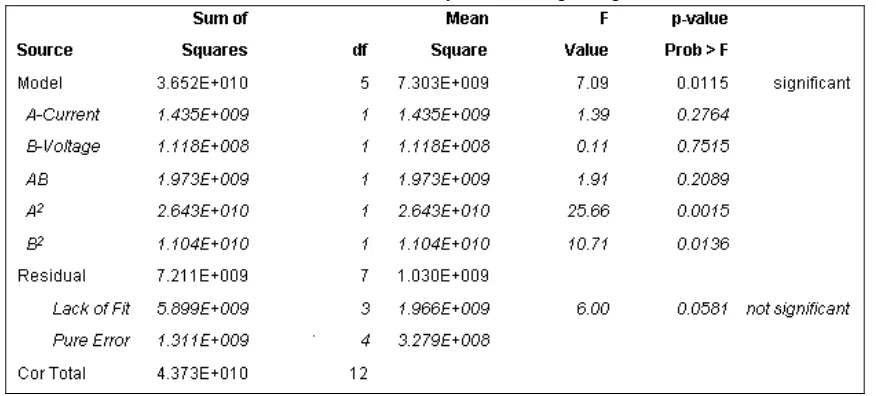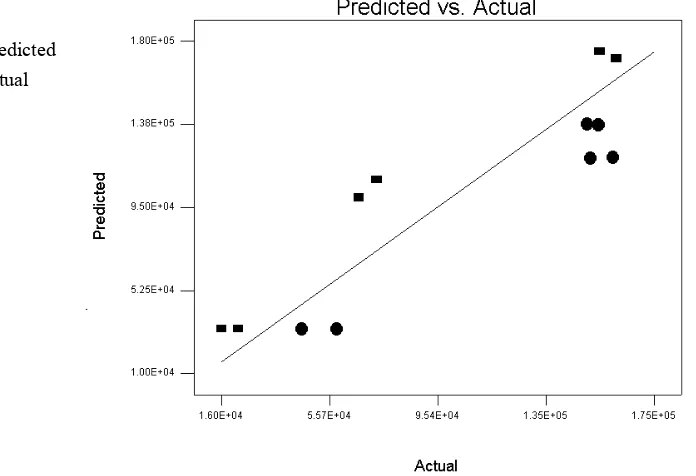PREDICTION OF THE BENDING STRENGTH
USING RESPONSE SURFACE METHODOLOGY
Ahmad Kamely
1, Ermansyah Sachlan
2, Sivarao Subramonian
31
Dr. Faculty of Manufacturing Engineering,
2,3
Faculty of Manufacturing Engineering
Universiti Teknikal Malaysia Melaka
Hang Tuah Jaya, 71000 Durian Tunggal
Melaka
,
MALAYSIA
[email protected]
Abstract
Response surface methodology (RSM) is a collection of data that used mathematical and statistical technique to model and analyze problem in which the response (output) are influenced by several factors (parameters). In this study, a mathematical model was developed using RSM to predict the bending strength of aluminium alloys 6064 weldment. Data analysis is performed using Design Expert 7.03. The adequacy of the models has been attempted by using analysis-of-variance (ANOVA) technique. Experimental results showed that model has 90% confidence level and the model can be use to predict the bending strength of Aluminium alloys 6064 weldments within the range of parameter considered in this investigation.
1. Introduction
Mathematical modeling is not only used in applied science but also in engineering field. Mathematical modeling was used to predict the mechanical properties (e.g tensile strength, grain size and hardness) of argon tungsten pulse current arc welded titanium alloy weldments and using RSM to develop the model. The models was checked by ANOVA technique which shown with 99% confidence level [1,2]. Optimization is a key to improve quality characteristic and optimization of the process without increasing the cost [3].
The quality of welded material can be evaluated by many characteristics [4]. Mathematical models need to be developed to make effective use of automated or robotic arc welding [5]. The survey reveals the high level of interest in the adaptation of RSM to predict responses and to optimize the welding process. Considerable attention has been focused in recent years on understanding microstructure and mechanical properties changes observed in the weldment area. RSM explores the relationship between several factors or more response. The objective of this method is to optimize the responses [6].
RSM was used to predict bending strength of aluminium weldment area of Metal Inert Gas (MIG) robot welding. By using the optimum welding sequence [7] the flatness of the panel can be improved and angular distortion in the skin plate can be minimize. Speciments cracks propagated either from the Heat
Affected Zone (HAZ) of the face or the root pass and spread across the specimen [8], Thomas & Nicholas (1998) also reported the failure occurring in the HAZ region. The goal of this study is to know the interaction between current and voltage that affect the bending strength.
2. Experimental Design
Aluminium alloys 6064 were welded by using MIG robot welding. Testing speciments was prepared according to ASTM (E-290-02) standard. The bending test was conducted using Universal Testing Machine. Different welding parameter was evaluated using Trapezium 2 software. Filler wire ER 4043 with diameter 1 mm was used, the welding speed 15 mm/min and shielding gas using pure argon (99%) with flow rate 15 lit/min. The current between 170-190 Ampere and the voltage variations were 16-20 volt. (see Table 1)
The adequacy of the model is tested using the sequential model sum of square, lack-of-fit test and the analysis-of-variance (ANOVA). This research only focusing on bending strength of aluminium alloys 6064 weldment by MIG robot welding.
Table 1 Process control parameters and their limits
Factor
Parameter
Units
Actual
Low
Actual
High
A
Current
A 170 190
B
Voltage
V 16 20
3. Result and Discussion
The investigation results consist of the model simulation of bending strength, model verification and analysis of the welding parameters effect.
3.1 Bending Strength
The bending strength test of materials is obtained from combinations of 13 parameters which consist of 4 test factorial points, 4 tests of axial points and 5 tests of center points and the influence of current and voltage on the bending strength is shown in Figure 1.
Fig.1 The 3D plot of bending strength ratio as a function of current and voltage
Table 2 shows the ANOVA analysis for response surface quadratic model for bending strength. The Model F-value of 7.09 implies the model is significant. There is only a 1.15% chance that a F-Value this could occur due to noise. Values of Prob>F less than 0.0500 indicated model terms are significant model and non-significant lack of fit. The quadratic model bending as
function of current and voltage can be written in equation 1:
Bending = (2.66541E+007) – (2.44824E+005 Current)– (5.24945E+005Voltage) + (628.28858Current2) + (9080.40434Voltage2) (1)
Table 2 The ANOVA analysis to bending strength
From the results, it shows that the bending strength was affected by current and voltage (see Figure 1). It was observed that the bending strength increased with used of high current and high voltage (161086 Mpa).
3.2 Validation Result
The result from RSM was verified by using the optimal levels of the welding process parameters. Figure 2 shows the relationship between the actual and
predicted values of bending strength, the measured values trend to be close to the diagonal line, indicating that the model adequately describes the response within the limits of the factors being investigated herein.
predicted actual
Fig. 2 Exhibited predicted values vs. actual of Bending strength
The actual results, predicted values and calculated percentage error of confirmation experiments are shown in Table 3. It is observed from the validation experiments that there is a small percentage error between prediction and actual. The model has shown 90 % confidence level for the bending strength.
Table 3 Validation result
Current (A)
Voltage (V)
Bending strength predict actual Error
(%)
170 17 101000 109485 8.40 185 17 57100 58828 3.02 190 19 131000 137664 5.09 170 19 82100 74789 -8.90 180 16 65600 59703 -8.99
4. Conclusions
Using response surface methodology, welding parameters which are influencing the bending strength have been modeled. From this study we can concluded that the model has shown 90% confidence level, and the model can be use to predict the bending strength of Aluminium alloys 6064 weldments of MIG robot welding within the range of parameter considered in this investigation. From this investigation it was observed that the bending strength increased with used of high current and high voltage (161086 Mpa). The increasing in bending strength is related to the heat input.
Acknowledgement
Financial support from The Ministry of Science, Technology and Innovation, Malaysia through the PJP funding grant no: PJP/2009/FKP(12A)S580 is acknowledge with gratitude.
References
[1] M. Balasubramanian, V. Jayabalan, and V. Balasubramanian, "Developing Mathematical Models to Predict Grain Size and Hardness of Argon Tungsten Pulse," materials processing technology, vol. 196, 2007, pp. 222-229.
[2] M. Balasubramanian, "Developing Mathematical Models to Predict Tensile Properties of Pulsed Current Gas Tungsten Arc Welded Ti – 6Al – 4V alloy," Materials and Design, vol. 29, 2008, pp. 92-97.
Geometry in The Tungsten Inert Gas Welding of Stainless Steel," Journal of Materials Processing Technology, vol. 122, 2002, pp. 33-37.
[4] D.S. Correia, C.V. Gonçalves, S. Simões, and V.A. Ferraresi, "Comparison Between Genetic Algorithms and Response Surface
Methodology in GMAW Welding
Optimization," Journal of Materials Processing Technology, vol. 160, 2005, pp. 70-76.
[5] I.S. Kim, K.J. Son, Y.S. Yang, and P.K. Yaragada, "Sensitivity Analysis for Process Parameters in GMA Welding Processes Using a Factorial Design Method," International Journal, vol. 43, 2003, pp. 763-769.
[6] D.C. Montgomery, Design and Analysis of Experiment, United States of America: John Wiley & Sons, Inc, 2005.
[7] B.Y. Tsai and P.T. Cheng, "Welding Distortion of a Thin-Plate Panel Structure," 1999, pp. 156-165.
[8] S. Katsas, "Microstructural Changes Accompanying Repair Welding in 5xxx Aluminium Alloys and Their Effect on the Mechanical Properties," Materials and Design, vol. 27, 2006, pp. 968-975.
[9] W.M. Thomas and E.D. Nicholas, "Friction Stir Welding for the Transportation Industries,"
Materials and Design, vol. 18, 1998, pp. 269-273.

